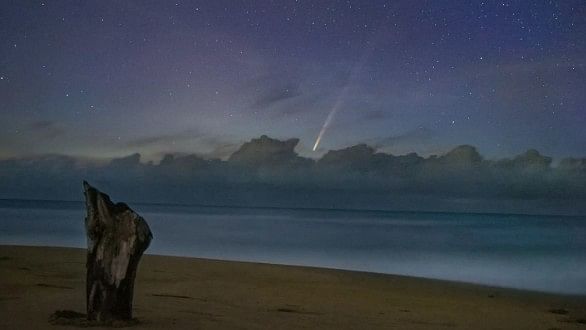
Comet C/2023 A3, captured from Mahabalipuram by Indian astrophotographer Sathya Narayanan Sridhar.
Credit: Instagram/@sathya_narayanan_sridhar
A comet last seen a whopping 80,000 years ago flew past the Pale Blue Dot this week, giving Earth-dwellers an exceedingly rare glimpse of a grand celestial event.
The comet, formally known as C/2023 A3 (Tsuchinshan-ATLAS), became visible to people living in India in the first week of October, and is expected to come closest to Earth in the days between October 12 and 24.
Understandably, stargazers had a gala time, and by extension, social media users, as astrophotographers from across the country uploaded breathtaking photos of the once-in-80-millennia event.
@cosmic_trails was one such account which posted on Instagram a stunning photograph of the comet, juxtaposed against mountains in Ladakh.
"On 1st October morning the astrophotography masterclass team travelled to Gongma la (4880 mt above sea level) to capture the comet. The oxygen and temperature was low but the spirits of the team were high. Most of the team was first time astrophotographers, but the way they were able to cope up with tough situations was amazing," the post read, and credited photographers Abhinav Singhai, Atish Aman, Lakshmi Narayana, Pritam Panigrahi, Smita Singh, Anuj Singh and Angchok Padma for the grand sight.
Another Indian astrophotographer—Sathya Narayanan Sridhar—was also able to capture the comet in all its glory, taking a stunning shot of the celestial object from Mahabalipuram in Tamil Nadu.
"With favourable weather conditions on a streak, we planned a trip to catch the comet before we lose it to the twilight in coming days. This was a place we frequent – Near Mahabalipuram,” and “…when the twilight broke, the eastern horizon gave way and comet peeped out of a veil of cloud hanging close the sea. We could spot the tail and the coma naked eye very easily. An unbelievably long tail – in-fact I had to reduce the focal length to 24mm to capture it in its entirety!" Sridhar wrote on Instagram as he shared the awe-inspiring photograph.
The comet was spotted from India's IT hub Bengaluru as well, with city-based astrophotographer and Bangalore Astronomical Society (BAS) member Keerthi Kiran M capturing a zoomed-in glimpse of the icy object.
"I clicked this image in the heart of Bangalore. In the next few days, if the sky is clear, you should be able to spot it in the morning between 5 AM and 5:45 AM. This is a stacked image which shows the beautiful long tail of the comet," she wrote, offering users a promise of more stunning photos to come.
India's other IT hub—Hyderabad—was also privy to the sensational sight, with X user @itsardnepu sharing a spectacular photo of the comet, captured from the outskirts of the city.
Discovered on January 9, 2023 by the Purple Mountain Observatory in China and later independently confirmed by ATLAS South Africa in February of the same year.
The comet is believed to have originated from the Oort Cloud, at the edge of our solar system.